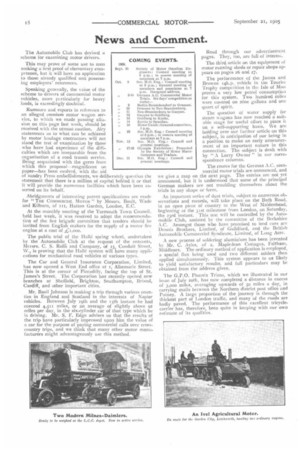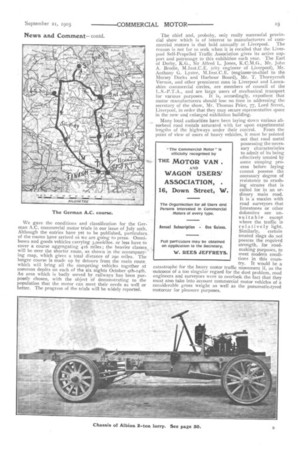News and Comment.
Page 2

Page 3

If you've noticed an error in this article please click here to report it so we can fix it.
The Automobile Club has devised a scheme for examining motor drivers.
This may prove of some use to men seeking a hrst proof of elementary competence, but it will have no application to those already qualified and possessing employers' references.
Speaking generally, the vaiue of the scheme to drivers of commercial motor vehicles, more particularly for heavy loads, is exceedingly doubtful.
Rumours and reports in reference to an alleged otnnium motor wagon service, to which we made passing allusion on this page last week, should be received with the utmost caution. Airy statements as to what can be achieved by motor haulage contractors will not stand the test of examination by those . who have had experience of the difficulties which are inseparable from the organisation of a road transit service. Being acquainted with the germ from which this proposal—magnificent on paper—has been evolved, with the aid of sundry Press embellishments, we deliberately question the statement that there is a million of capital behind it or that It will provide the numerous facilities which have been asserted on its behalf.
Abridgments of interesting patent specifications are made for "THE COMMERCIAL MOTOR by Messrs. Boult, Wade and Kilburn, of tit, Hatton Garden, London, E.C.
At the monthly meeting of the Yarmouth Town Council, held last week, it was resolved to adopt the recommendation of the fire brigade committee that tenders should be invited from English makers for the supply of a motor fire engine at a cost of The public trial of the Halle spring wheel, undertaken by the Automobile Club at the request of the entrants, Messrs. C. S. RollS and Company, of Is, Conduit Street, W., is proving that the Halle: system will have many applications for mechanical road vehicles of various types.
The Car and General Insurance Corporation, Limited, has now opened a West End office at 1, Albemarle Street. This is at the corner of Piccadilly, facing the top of St. James's Street. The Corporation has recently opened new branches at Sheffield, Brighton, Southampton, Bristol, Cardiff, and other important cities.
Mr. Basil Johnson is making a trip through various counties in England and Scotland in the interests of Napier vehicles. Between July 19th and the f3th instant he had covered 4,511 miles, or an average of slightly above 92 miles per day, in the six-cylinder car of that type which he is driving. Mr. S. F. Edge advises us that the results of the trip have particularly impressed upon him the value of a car for the purpose of paying commercial calls over crosscountry trips, and we think that many other motor manufacturers might advantageously use this method. Read through our advertisement pages. They, too, are full of interest.
The third article on the equipment of motor running studs or repair shops appears on pages 26 and 27.
The performance of the James and Browne 14h.p. vehicle in tne Tourist Trophy competition in the Isle of Man proves a very low petrol consumptioo for this system. Two hundred miles were covered on nine gallons and one quart of spirit.
The question of water supply for steam wagons has now reached a suitable stage for useful effort to place it on a self-supporting basis. We are holding over our further article on this subject, in anticipation of our being in a position to make an early announcement of an important nature in this connection. The subject is dealt with by "A Lorry Owner" in our correspondence columns.
The routes for the German A.C. commercial motor trials are announced, and we give a map on the next page. The entries are not yet announced, but it is understood that some of the principal German makers are not troubling themselves about the trials in any shape or form.
An important series of dust trials, subject to numerous observations and records, will take place on the Bath Road, in an open piece of country to the West of Maidenhead, beginning at the 31st milestone from London, on Saturday, the 23rd instant. This test will be controlled by the Automobile Club, assisted by the committee of the Berkshire A.C. Amongst those who have promised to lend cars are Dennis Brothers, Limited, of Guildford, and the British Automobile Commercial Syndicate, Limited, of Long Acre_ A new process of soldering aluminium has been invented by Mr. C. Ayles, of 2, Mapiedean Counge.s, Feltham, Middlesex. The ordinary method of application is employed, a special flux being used and two different solders then applied simultaneously. This system appears to us likely to yield satisfactory results, and full particulars may be obtained from the address given.
The G.P.O. Phosnix Trim°, which we illustrated in our issue of July 20th, has now completed a distance in excess of 3,000 miles, averaging upwards of 50 miles a day, in carrying mails bei.ween the Northern district post office and Putney. A large proportion of the journey is through the thickest part of London traffic, and many of the roads are badly paved. The performance of this excellent tricyclecarrier has, therefore, been quite in keeping with our own estimate of its qualities. We gave the conditions and classification for the German A.C. commercial motor trials in our issue of July 20th. Although the entries have yet to be published, particulars of the routes have arrived as we are going to press. Omnibuses and goods vehicles carrying 3,000kilos. or less have to cover a course aggregating 416 miles; the heavier classes will be over the shorter route, as shown in the accompanying map, which gives a total distance of 290 miles. The longer course is made up by detours from the main route. which will bring all the competing vehicles together at common depots on each of the six nights October 9th-4th. An area which is badly served by railways has been purposely chosen, with the object of demonstrating to the population that the motor can meet their needs as well or better. The progress of the trials will be widely reported. The chief and, probaby, only really successful provincial show which is of interest to manufacturers of commercial motors is that held annually at Liverpool. The reason is not far to seek when it is recalled that the Liverpool Self-Propelled Traffic Association gives its active support and patronage to this exhibition each year. • The Earl of Derby, K.G., Sir Alfred L. Jones, K.C.M.G., Mr. John A. Brodie, M.Inst.C.E. (city engineer of Liverpool), Mr. Anthony (.1. Lyster, M.Inst.C.E. (engineer-in-chief to the Mersey Docks and Harbour Board), Mr. T. Thornycroft Vernon, and other prominent men in Liverpool and Lancashire commercial circles, are members of council of the L.S.-P.T.A., and are large users of mechanical transport for various purposes. It is, accordingly, expedient that motor manufacturers should lose no time in addressing the secretary of the show, Mr. Thomas Price, n, Lord Street, Liverpool, in order that they may secure representative space in the new and enlarged exhibition building.
Many local authorities have been laying down various ab sorbent road metals saturated with tar upon experimental
lengths of the highways under their control. From the point of view of users of heavy velfcles, it must he pointed out that road metal possessing the necessary characteristics to admit of its being effectively treated by some steeping process before -laying
' The Commercial Motor" Is officially recognised by
THE MOTOR VAN.
A,41)
cannot possess the necessary degree of resistance to crushMg strains that is called tor in an ordinary main road. It is a maxim with road surveyors that limestones or other dolomites are tinsuitable.except where the traffic is relatively light. Similarly, certain treated slags do not possess the required strength, for roadmaking purposes, to meet modern conditions in this coun
try. It would be a catastrophe for the heavy motor traffic movement if, as the outcome of a too singular regard for the dust problem, road engineers and surveyors were to overlook the fact that they must also take into account commercial motor vehicles of a considerable gross weight as well as the pneumatic-tyred motorcar for pleasure purposes.
















